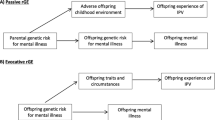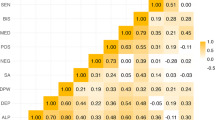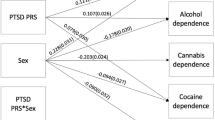Abstract
Women who have experienced childhood sexual abuse (CSA) have an increased risk of alcoholism and antisocial personality disorder (ASPD). Among male subjects, a functional polymorphism (MAOA-LPR, monoamine oxidase A linked polymorphic region) in the promoter region of the monoamine oxidase A gene (MAOA) appears to moderate the effect of childhood maltreatment on antisocial behavior. Our aim was to test whether MAOA-LPR influences the impact of CSA on alcoholism and ASPD in a sample of 291 women, 50% of whom have experienced CSA; we also tested whether haplotypes covering the region where both MAOA and monoamine oxidase B (MAOB) genes are located predict risk of alcoholism and ASPD better than the MAOA-LPR locus alone. Participants included 168 alcoholics (39 with ASPD (antisocial alcoholics) and 123 controls (no alcoholics, no ASPD). Antisocial behavior was also modeled as a continuous trait: ASPD symptoms count. The MAOA-LPR low activity allele was associated with alcoholism (P=0.005), particularly antisocial alcoholism (P=0.00009), only among sexually abused subjects. Sexually abused women who were homozygous for the low activity allele had higher rates of alcoholism and ASPD, and more ASPD symptoms, than abused women homozygous for the high activity allele. Heterozygous women displayed an intermediate risk pattern. In contrast, there was no relationship between alcoholism/antisocial behavior and MAOA-LPR genotype among non-abused women. The MAOA-LPR low activity allele was found on three different haplotypes. The most abundant MAOA haplotype containing the MAOA-LPR low activity allele was found in excess among alcoholics (P=0.008) and antisocial alcoholics (P=0.001). Finally, a MAOB haplotype, which we termed haplotype C, was significantly associated with alcoholism (P=0.006), and to a lesser extent with antisocial alcoholism (P=0.03). In conclusions, MAOA seems to moderate the impact of childhood trauma on adult psychopathology in female subjects in the same way as previously shown among male subjects. The MAOA-LPR low activity allele appears to confer increased vulnerability to the adverse psychosocial consequences of CSA. Haplotype-based analysis of the MAOA gene appeared to strengthen the association, as compared to the MAOA-LPR locus alone. A MAOB haplotype was associated with alcoholism independently from ASPD.
This is a preview of subscription content, access via your institution
Access options
Subscribe to this journal
Receive 12 print issues and online access
$259.00 per year
only $21.58 per issue
Buy this article
- Purchase on Springer Link
- Instant access to full article PDF
Prices may be subject to local taxes which are calculated during checkout




Similar content being viewed by others
References
Molnar BE, Buka SL, Kessler RC . Child sexual abuse and subsequent psychopathology: results from the National Comorbidity Survey. Am J Public Health 2001; 91: 753–760.
Galaif ER, Stein JA, Newcomb MD, Bernstein DP . Gender differences in the prediction of problem alcohol use in adulthood: exploring the influence of family factors and childhood maltreatment. J Stud Alcohol 2001; 62: 486–493.
Mullen PE, Martin JL, Anderson JC, Romans SE, Herbison GP . Childhood sexual abuse and mental health in adult life. Br J Psychiatry 1993; 163: 721–732.
Robin RW, Chester B, Rasmussen JK, Jaranson JM, Goldman D . Prevalence, characteristics, and impact of childhood sexual abuse in a Southwestern American Indian tribe. Child Abuse Negl 1997; 21: 769–787.
Horwitz AV, Widom CS, McLaughlin J, White HR . The impact of childhood abuse and neglect on adult mental health: a prospective study. J Health Soc Behav 2001; 42: 184–201.
Kendler KS, Bulik CM, Silberg J, Hettema JM, Myers J, Prescott CA . Childhood sexual abuse and adult psychiatric and substance use disorders in women: an epidemiological and cotwin control analysis. Arch Gen Psychiatry 2000; 57: 953–959.
Briere J, Runtz M . Symptomatology associated with childhood sexual victimization in a nonclinical adult sample. Child Abuse Negl 1988; 12: 51–59.
Nelson EC, Heath AC, Madden PA, Cooper ML, Dinwiddie SH, Bucholz KK et al. Association between self-reported childhood sexual abuse and adverse psychosocial outcomes: results from a twin study. Arch Gen Psychiatry 2002; 59: 139–145.
Kendler KS, Kuhn JW, Prescott CA . Childhood sexual abuse, stressful life events and risk for major depression in women. Psychol Med 2004; 34: 1475–1482.
Roy A, Janal M . Gender in suicide attempt rates and childhood sexual abuse rates: is there an interaction? Suicide Life Threat Behav 2006; 36: 329–335.
Joiner Jr TE, Sachs-Ericsson NJ, Wingate LR, Brown JS, Anestis MD, Selby EA . Childhood physical and sexual abuse and lifetime number of suicide attempts: a persistent and theoretically important relationship. Behav Res Ther 2006; 45: 539–547.
Widom CS . Posttraumatic stress disorder in abused and neglected children grown up. Am J Psychiatry 1999; 156: 1223–1229.
Tolin DF, Foa EB . Sex differences in trauma and posttraumatic stress disorder: a quantitative review of 25 years of research. Psychol Bull 2006; 132: 959–992.
Robin RW, Chester B, Goldman D . Cumulative trauma and PTSD in American Indian communities. In: Marseala AJ, Friedman MJ, Gerrity ET, Scurfield RM (eds). Ethnocultural Aspects of Posttraumatic Stress Disorder: Issues, Research, and Clinical Applications. American Psychological Association: Washington, DC, 1996, pp 239–253.
Robin RW, Long JC, Rasmussen JK, Albaugh B, Goldman D . Relationship of binge drinking to alcohol dependence, other psychiatric disorders, and behavioral problems in an American Indian tribe. Alcohol Clin Exp Res 1998; 22: 518–523.
Compton WM, Conway KP, Stinson FS, Colliver JD, Grant BF . Prevalence, correlates, and comorbidity of DSM-IV antisocial personality syndromes and alcohol and specific drug use disorders in the United States: results from the national epidemiologic survey on alcohol and related conditions. J Clin Psychiatry 2005; 66: 677–685.
Caspi A, McClay J, Moffitt TE, Mill J, Martin J, Craig IW et al. Role of genotype in the cycle of violence in maltreated children. Science 2002; 297: 851–854.
Foley DL, Eaves LJ, Wormley B, Silberg JL, Maes HH, Kuhn J et al. Childhood adversity, monoamine oxidase a genotype, and risk for conduct disorder. Arch Gen Psychiatry 2004; 61: 738–744.
Huang YY, Cate SP, Battistuzzi C, Oquendo MA, Brent D, Mann JJ . An association between a functional polymorphism in the monoamine oxidase a gene promoter, impulsive traits and early abuse experiences. Neuropsychopharmacology 2004; 29: 1498–1505.
Nilsson KW, Sjoberg RL, Damberg M, Leppert J, Ohrvik J, Alm PO et al. Role of monoamine oxidase A genotype and psychosocial factors in male adolescent criminal activity. Biol Psychiatry 2006; 59: 121–127.
Kim-Cohen J, Caspi A, Taylor A, Williams B, Newcombe R, Craig IW et al. MAOA, maltreatment, and gene-environment interaction predicting children's mental health: new evidence and a meta-analysis. Mol Psychiatry 2006; 11: 903–913.
Lan NC, Heinzmann C, Gal A, Klisak I, Orth U, Lai E et al. Human monoamine oxidase A and B genes map to Xp 11.23 and are deleted in a patient with Norrie disease. Genomics 1989; 4: 552–559.
Cases O, Seif I, Grimsby J, Gaspar P, Chen K, Pournin S et al. Aggressive behavior and altered amounts of brain serotonin and norepinephrine in mice lacking MAOA. Science 1995; 268: 1763–1766.
Sabol SZ, Hu S, Hamer D . A functional polymorphism in the monoamine oxidase A gene promoter. Hum Genet 1998; 103: 273–279.
Deckert J, Catalano M, Syagailo YV, Bosi M, Okladnova O, Di Bella D et al. Excess of high activity monoamine oxidase A gene promoter alleles in female patients with panic disorder. Hum Mol Genet 1999; 8: 621–624.
Sjoberg RL, Nilsson KW, Wargelius HL, Leppert J, Lindstrom L, Oreland L . Adolescent girls and criminal activity: role of MAOA-LPR genotype and psychosocial factors. Am J Med Genet B Neuropsychiatr Genet 2006; 144: 159–164.
Widom CS, Brzustowicz LM . MAOA and the ‘cycle of violence:’ childhood abuse and neglect, MAOA genotype, and risk for violent and antisocial behavior. Biol Psychiatry 2006; 60: 684–689.
Pinsonneault JK, Papp AC, Sadee W . Allelic mRNA expression of X-linked monoamine oxidase a (MAOA) in human brain: dissection of epigenetic and genetic factors. Hum Mol Genet 2006; 15: 2636–2649.
Rosenberg S, Templeton AR, Feigin PD, Lancet D, Beckmann JS, Selig S et al. The association of DNA sequence variation at the MAOA genetic locus with quantitative behavioural traits in normal males. Hum Genet 2006; 120: 447–459.
Mayfield D, McLeod G, Hall P . The CAGE questionnaire: validation of a new alcoholism screening instrument. Am J Psychiatry 1974; 131: 1121–1123.
Saremi A, Hanson RL, Williams DE, Roumain J, Robin RW, Long JC et al. Validity of the CAGE questionnaire in an American Indian population. J Stud Alcohol 2001; 62: 294–300.
Spitzer RL, Endicott J, Robins E . Research Diagnostic Criteria (RDC) for a Selected Group of Functional Disorders. Department of Research Assesment and Training. New York Psychiatric Institute: New York, 1989.
Spitzer RL, Endicott J . Schedule for Affective Disorders and Schizophrenia Lifetime Version (SADS-L). Research Assesment and Training Unit. New York Psychiatric Institute: New York, 1979.
Fink LA, Bernstein D, Handelsman L, Foote J, Lovejoy M . Initial reliability and validity of the childhood trauma interview: a new multidimensional measure of childhood interpersonal trauma. Am J Psychiatry 1995; 152: 1329–1335.
Conte JR, Berliner L . The impact of sexual abuse on children: empirical findings. In: Walker LKA (ed). Handbook on Sexual Abuse of Children: Assesment and Treatment Issues. Springer: New York, 1998, pp 1–31.
Barrett JC, Fry B, Maller J, Daly MJ . Haploview: analysis and visualization of LD and haplotype maps. Bioinformatics 2005; 21: 263–265.
Stephens M, Donnelly P . A comparison of bayesian methods for haplotype reconstruction from population genotype data. Am J Hum Genet 2003; 73: 1162–1169.
Heim C, Newport DJ, Heit S, Graham YP, Wilcox M, Bonsall R et al. Pituitary-adrenal and autonomic responses to stress in women after sexual and physical abuse in childhood. JAMA 2000; 284: 592–597.
Barr CS, Newman TK, Schwandt M, Shannon C, Dvoskin RL, Lindell SG et al. Sexual dichotomy of an interaction between early adversity and the serotonin transporter gene promoter variant in rhesus macaques. Proc Natl Acad Sci USA 2004; 101: 12358–12363.
Mirescu C, Peters JD, Gould E . Early life experience alters response of adult neurogenesis to stress. Nat Neurosci 2004; 7: 841–846.
Meyer-Lindenberg A, Buckholtz JW, Kolachana B, Hariri A, Pezawas L, Blasi G et al. Neural mechanisms of genetic risk for impulsivity and violence in humans. Proc Natl Acad Sci USA 2006; 103: 6269–6274.
Benjamin D, Van Bakel I, Craig IW . A novel expression based approach for assessing the inactivation status of human X-linked genes. Eur J Hum Genet 2000; 8: 103–108.
Carrel L, Willard HF . X-inactivation profile reveals extensive variability in X-linked gene expression in females. Nature 2005; 434: 400–404.
Balciuniene J, Emilsson L, Oreland L, Pettersson U, Jazin E . Investigation of the functional effect of monoamine oxidase polymorphisms in human brain. Hum Genet 2002; 110: 1–7.
Grimsby J, Chen K, Wang LJ, Lan NC, Shih JC . Human monoamine oxidase A and B genes exhibit identical exon–intron organization. Proc Natl Acad Sci USA 1991; 88: 3637–3641.
Lakshmana MK, Rao BS, Dhingra NK, Ravikumar R, Govindaiah G, Sudha S et al. Role of monoamine oxidase type A and B on the dopamine metabolism in discrete regions of the primate brain. Neurochem Res 1998; 23: 1031–1037.
Stenstrom A, Hardy J, Oreland L . Intra- and extra-dopamine-synaptosomal localization of monoamine oxidase in striatal homogenates from four species. Biochem Pharmacol 1987; 36: 2931–2935.
Fowler CJ, Oreland L . Substrate- and stereoselective inhibitor of human brain monoamine oxidase by 4-dimethylamino-alpha, 2-dimethylphenethylamine (FLA 336). J Pharm Pharmacol 1981; 33: 403–406.
Arai Y, Kinemuchi H, Hamamichi N, Satoh N, Tadano T, Kisara K . Inhibition of rat brain monoamine oxidase by some analogues of 1-methyl-4-phenyl-1,2,3,6-tetrahydropyridine and 1-methyl-4-phenylpyridinium ion. Neurosci Lett 1986; 66: 43–48.
White HL, Glassman AT . Multiple binding sites of human brain and liver monoamine oxidase: substrate specificities, selective inhibitions, and attempts to separate enzyme forms. J Neurochem 1977; 29: 987–997.
Thorpe LW, Westlund KN, Kochersperger LM, Abell CW, Denney RM . Immunocytochemical localization of monoamine oxidases A and B in human peripheral tissues and brain. J Histochem Cytochem 1987; 35: 23–32.
Westlund KN, Denney RM, Rose RM, Abell CW . Localization of distinct monoamine oxidase A and monoamine oxidase B cell populations in human brainstem. Neuroscience 1988; 25: 439–456.
Arai R, Kimura H, Nagatsu I, Maeda T . Preferential localization of monoamine oxidase type A activity in neurons of the locus coeruleus and type B activity in neurons of the dorsal raphe nucleus of the rat: a detailed enzyme histochemical study. Brain Res 1997; 745: 352–356.
Devor EJ, Abell CW, Hoffman PL, Tabakoff B, Cloninger CR . Platelet MAO activity in type I and type II alcoholism. Ann N Y Acad Sci 1994; 708: 119–128.
Barnholtz JS, de Andrade M, Page GP, King TM, Peterson LE, Amos CI . Assessing linkage of monoamine oxidase B in a genome-wide scan using a univariate variance components approach. Genet Epidemiol 1999; 17 (Suppl 1): S49–S54.
Lin S, Jiang S, Wu X, Qian Y, Wang D, Tang G et al. Association analysis between mood disorder and monoamine oxidase gene. Am J Med Genet 2000; 96: 12–14.
Garpenstrand H, Ekblom J, Forslund K, Rylander G, Oreland L . Platelet monoamine oxidase activity is related to MAOB intron 13 genotype. J Neural Transm 2000; 107: 523–530.
Fowler JS, Wiberg A, Oreland L, Marcusson J, Winblad B . The effect of age on the activity and molecular properties of human brain monoamine oxidase. J Neuroal Trasm 1980; 49: 1–20.
Berlin I, Anthenelli RM . Monoamine oxidases and tobacco smoking. Int J Neuropsychopharmacol 2001; 4: 33–42.
Acknowledgements
This research was supported by the Intramural Research Program of the National Institute on Alcohol Abuse and Alcoholism, NIH, and in part by the Office of Research on Minority Health.
Author information
Authors and Affiliations
Corresponding author
Additional information
Supplementary Information accompanies the paper on the Molecular Psychiatry website (http://www.nature.com/mp)
Rights and permissions
About this article
Cite this article
Ducci, F., Enoch, MA., Hodgkinson, C. et al. Interaction between a functional MAOA locus and childhood sexual abuse predicts alcoholism and antisocial personality disorder in adult women. Mol Psychiatry 13, 334–347 (2008). https://doi.org/10.1038/sj.mp.4002034
Received:
Revised:
Accepted:
Published:
Issue Date:
DOI: https://doi.org/10.1038/sj.mp.4002034
Keywords
This article is cited by
-
SLC25A24 gene methylation and gray matter volume in females with and without conduct disorder: an exploratory epigenetic neuroimaging study
Translational Psychiatry (2021)
-
Does prior traumatization affect the treatment outcome of CBT for panic disorder? The potential role of the MAOA gene and depression symptoms
European Archives of Psychiatry and Clinical Neuroscience (2019)
-
Childhood Trauma and Two Stages of Alcohol Use in African American and European American Women: Findings from a Female Twin Sample
Prevention Science (2018)
-
Personality as an intermediate phenotype for genetic dissection of alcohol use disorder
Journal of Neural Transmission (2018)
-
Type A and B monoamine oxidases distinctly modulate signal transduction pathway and gene expression to regulate brain function and survival of neurons
Journal of Neural Transmission (2018)



